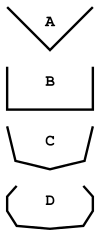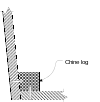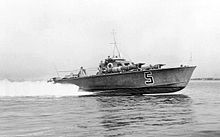Chime walk 32 dominator
#1
Registered
Thread Starter
Join Date: Jun 2014
Posts: 5
Likes: 0
Received 0 Likes
on
0 Posts
I have a 2000 sunsation dominator with twin 502s with bravo one drives get bad chime walk 60 plus. I just bought the boat recently and moved up from a 27 Powerquest with twin 350s top speed of 60! So I am more of a rookie to driving this haul any help. Is it normal for these dominator to get chime?
#2
Registered
iTrader: (3)
Chine son, CHINE...
https://en.wikipedia.org/wiki/Chine_(boating)
A chine in boating refers to a sharp change in angle in the cross section of a hull. A hull without chines has a gradually curving cross section. The term hard chine indicates an angle with little rounding, where a soft chine would be more rounded, but still involve the meeting of distinct planes. Chine log constructionis a method of building hard chine boat hulls. Hard chines are common in plywood hulls, while soft chines are often found on fiberglass hulls.
The first hulls to start incorporating hard chines were probably shallow draft cargo carrying vessels used on rivers and in canals.[1]
Once sufficiently powerful marine motors had been developed to allow powerboats to plane, it was found that the flat underside of a chined boat provided maximum hydrodynamic lift and speed.[2]
Working in the same inland waters as the sailing scows was the later river steamboat. River steamboats were often built using the same hard chined construction methods of the sailing scows, with a flat bottom, hard chine, and nearly vertical sides.[4]
The punt is one of the older and simplest hard chine small boats. Consisting usually of a single plank for each side, with a square bow and stern, the punt was in essence a tiny scow.[citation needed]
Different numbers of chinesThe simplest type of chine construction is the single chine "V" shape, with two flat panels joined at the keel (A). This type of hull is among the simplest to build, but they lack stability on a narrow "V" and may lack freeboard on a wide "V". Single chine hulls are generally only seen on multihull sailboats, which often use two deep "V" shaped hulls connected by akas to provide mutual stability.
The two chine hull (B), with a flat bottom and nearly vertical sides, was the first hard chine design to achieve widespread use. This design provides far more stability than the single chine hull, with minimum draft and a large cargo capacity. These characteristics make the two chine hull popular for punts, barges, and scows.
The three chine hull (C) is probably the most common hard chine hull. Having a shallow "V" in the bottom and near-vertical panels above that, it approximates the shape of traditional rounded hull boats fairly well. This hull is common, even in fiberglass designs where employing chines offers no advantage in construction.
Designs with higher numbers of chines (D), often just called multichine hulls, are also common. By increasing the number of chines, the hull can very closely approximate a round bottomed hull. Kayaks, in particular, are often composed of many chines, required for the complex shapes needed to provide good performance under various conditions.
It is possible to refer to the different hulls by the numbers of the flat panels that make up the boat. Thus A is a two-panel boat, B is a three-panel boat, C is a four-panel boat and D is an eight-panel boat.

Two planks joined by a chine log
Chine log construction works best for hulls where the sides join a flat bottom at a right angle, but it can be used for other angles as well with an appropriately angled chine log. Builders of small boats such as punts, where the plank thickness is large compared to the size of the hull, can dispense with the chine log and nail intersecting planks directly into one another.
Royal Navy World War II MTB
planing at speed on calm water showing its hard chine hull. Note how most of the forepart of the boat is out of the water.A chined hull built out of plywood will often be designed to keep most of the lengthwise joints between the plywood sheets at the chines, thus making the building process easier. While chine logs (often just called chines) can be used for plywood boats,[6] another common technique replaces the chine logs with a fiberglass and epoxy fillet joint that provides both connection and stiffness to the joint; this method is most commonly called stitch and glue construction.
https://en.wikipedia.org/wiki/Chine_(boating)
A chine in boating refers to a sharp change in angle in the cross section of a hull. A hull without chines has a gradually curving cross section. The term hard chine indicates an angle with little rounding, where a soft chine would be more rounded, but still involve the meeting of distinct planes. Chine log constructionis a method of building hard chine boat hulls. Hard chines are common in plywood hulls, while soft chines are often found on fiberglass hulls.
Contents
[hide]Reasons for chines[edit]
The oldest type of engineered boats are dugout canoes, which were built by hollowing out a log. These designs generally had rounded bottoms, which made best use of the round shape of the logs. Traditional planked hulls in most cultures are built by placing wooden planks oriented parallel to the waterflow and attached to bent wooden frames. This also produced a rounded hull, generally with a sharp bottom edge to form the keel. Planked boats were built in this manner for most of history.[citation needed]The first hulls to start incorporating hard chines were probably shallow draft cargo carrying vessels used on rivers and in canals.[1]
Once sufficiently powerful marine motors had been developed to allow powerboats to plane, it was found that the flat underside of a chined boat provided maximum hydrodynamic lift and speed.[2]
Boats using chines[edit]
The scow in particular, in the form of the scow schooner, was the first significant example of a hard chine sailing vessel. While sailing scows had a poor safety reputation, that was due more to their typical cheap construction and tendency to founder in storms. As long as it sailed in the protected inland and coastal waters it was designed to operate in, however, the sailing scow was an efficient and cost effective solution to transporting goods from inland sources to the coast.[citation needed] A good example of this is the gundalow.[3]Working in the same inland waters as the sailing scows was the later river steamboat. River steamboats were often built using the same hard chined construction methods of the sailing scows, with a flat bottom, hard chine, and nearly vertical sides.[4]
The punt is one of the older and simplest hard chine small boats. Consisting usually of a single plank for each side, with a square bow and stern, the punt was in essence a tiny scow.[citation needed]
Various types of chine hulls[edit]

Different numbers of chinesThe simplest type of chine construction is the single chine "V" shape, with two flat panels joined at the keel (A). This type of hull is among the simplest to build, but they lack stability on a narrow "V" and may lack freeboard on a wide "V". Single chine hulls are generally only seen on multihull sailboats, which often use two deep "V" shaped hulls connected by akas to provide mutual stability.
The two chine hull (B), with a flat bottom and nearly vertical sides, was the first hard chine design to achieve widespread use. This design provides far more stability than the single chine hull, with minimum draft and a large cargo capacity. These characteristics make the two chine hull popular for punts, barges, and scows.
The three chine hull (C) is probably the most common hard chine hull. Having a shallow "V" in the bottom and near-vertical panels above that, it approximates the shape of traditional rounded hull boats fairly well. This hull is common, even in fiberglass designs where employing chines offers no advantage in construction.
Designs with higher numbers of chines (D), often just called multichine hulls, are also common. By increasing the number of chines, the hull can very closely approximate a round bottomed hull. Kayaks, in particular, are often composed of many chines, required for the complex shapes needed to provide good performance under various conditions.
It is possible to refer to the different hulls by the numbers of the flat panels that make up the boat. Thus A is a two-panel boat, B is a three-panel boat, C is a four-panel boat and D is an eight-panel boat.

Two planks joined by a chine log
Plank hulls[edit]
Plank hulls use wooden supports placed along the chines called chine logs to provide strength where the chines joined. Beams are then attached to the chine log to support planks running parallel to the chine, while cross-planked sections such as a typical scow bottom may be attached directly to the chine log. This method of construction originated with the sailing scow[5] and continues to be used today, primarily in home built boats.Chine log construction works best for hulls where the sides join a flat bottom at a right angle, but it can be used for other angles as well with an appropriately angled chine log. Builders of small boats such as punts, where the plank thickness is large compared to the size of the hull, can dispense with the chine log and nail intersecting planks directly into one another.
Plywood hulls[edit]

Royal Navy World War II MTB
planing at speed on calm water showing its hard chine hull. Note how most of the forepart of the boat is out of the water.A chined hull built out of plywood will often be designed to keep most of the lengthwise joints between the plywood sheets at the chines, thus making the building process easier. While chine logs (often just called chines) can be used for plywood boats,[6] another common technique replaces the chine logs with a fiberglass and epoxy fillet joint that provides both connection and stiffness to the joint; this method is most commonly called stitch and glue construction.
#7
Registered
Are you just flat over trimming the boat, maybe too soon? Buddy has a 32 and its solid all the way to its max speed around 70mph - no hydro steering either.
3 blade props or 4 blade?
3 blade props or 4 blade?
#8
Registered
I put over 450 hours on the 2000 dominator I use to own. The only time I would get any hint of chine walk was from over trimming. Once it starts to walk on you tuck the drives in a bit and see if it goes away.
#10
Registered
Weird that you have 3 blades. I believe Wayne and Joe delivered the 32 with big blocks with 4 blades. Mine had 454 mags and came with 4 blades. 28P. I think the 496HO boats we're delivered with 30P 4 blades. You should be able to turn 30P labbed 4 blades. I'd call the factory and they will tell you exactly what prop to run.




